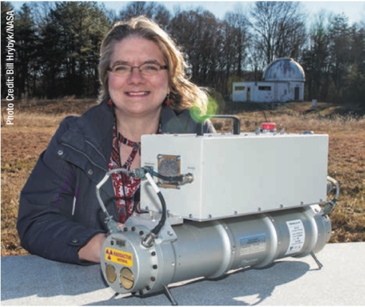
Goddard Space Flight Center, Greenbelt, Maryland 20771
ENGINEERING COLLOQUIUM
Monday, March 18, 2019 / 3:30 PM, Building 3 Auditorium

Ann Parsons
"The Bulk Elemental Composition Analyzer"
ABSTRACT -- The Bulk Elemental Composition Analyzer (BECA) is designed to analyze the top 20 centimeters of the Moon's surface. The instrument will send a pulse of neutrons into the lunar surface. The gamma rays and neutrons that come back will reveal what elements are present. Unlike some instruments, BECA does not need any moving parts, such as drills or scoops. it could operate from either a rover or a stationary lander.
BECA has been tested both in the laboratory and in the field. Laboratory tests were difficult to interpret; BECA was getting a signal back from both the test item and the laboratory surroundings. So a large stack of granite slabs was built at Goddard's Geophysical and Astronomical Observatory to serve as the test sample. One advantage of granite is that it does not absorb water, despite being rained and snowed on all year long.
BECA is currently being funded as part of NASA's Development and Advancement of Lunar Instrumentation (DALI) program.
SPEAKER -- Dr. Ann Parsons is the head of the Nuclear Planetary Science Instrumentation Program at Goddard. Her involvement with space nuclear instrumentation began with the Burst Alert Telescope (BAT) on the Neil Gehrels Swift Observatory. Other work in this area includes collaborating with Schlumberger Technology Corporation to adapt their Pulsed Neutron Generator (PNG), designed for use in the oil industry, for space flight applications.
To allow the safe testing of gamma ray and neutron instruments for use in Planetary Science, she built the Gamma ray Neutron Test (GNT) facility at Goddard's Geophysical and Astronomical Observatory. At this outdoor facility, researchers can test their instruments on top of large slabs of basalt and granite that simulate planetary surfaces.
Dr. Parsons has a PhD in physics from the University of California, Berkeley, and a BS in physics from the University of Michigan. Her work with BAT received a NASA Honor Award for Group Achievement and the AAS Bruno Rossi Prize. She also received the Robert H. Goddard Award for Exceptional Achievement for Science as part of the Planetary Geochemical Instrument Team.
Colloquium Committee Sponsor: Brent Warner
Engineering Colloquium home page: https://ecolloq.gsfc.nasa.gov